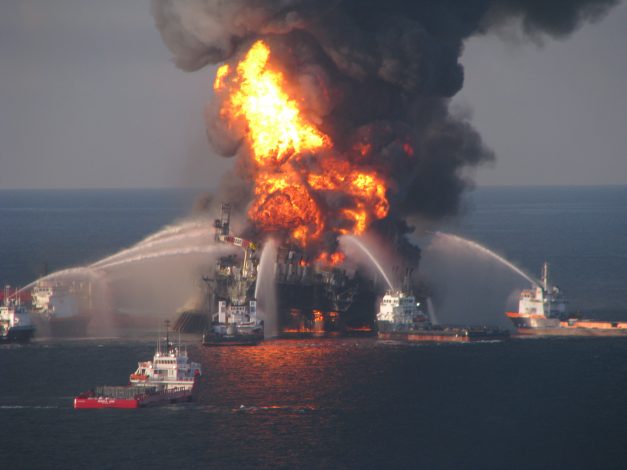Model shows dispersants improved air quality during 2010 gulf oil spill

Image: Wikimedia Commons
A recent study has added a new dimension to the controversial decision to inject large amounts of chemical dispersants immediately above the crippled oil well at the seafloor during the Deepwater Horizon disaster in 2010. The dispersants may have significantly reduced the amount of harmful gases in the air at the sea surface—reducing health risks for emergency responders and allowing them to keep working to stop the uncontrolled spill and clean up the spilled oil sooner.
Published Aug. 28 in the Proceedings of the National Academy of Sciences, the study used a model developed by Scott Socolofsky, a Texas A&M University professor in the Zachry Department of Civil Engineering, and his research team. The model is called the Texas A&M Oil spill Calculator (TAMOC).
In the midst of the Deepwater Horizon crisis, officials made the unprecedented and controversial decision to inject more than 700,000 gallons of chemical dispersant over 67 days immediately above the oil rig’s severed wellhead at the bottom of the ocean. The goal was to break up petroleum that surged uncontrollably from the wellhead into smaller droplets in the deep sea, with the goals of diminishing oil slicks and reducing the amount of harmful gases arriving at the ocean surface.
Proponents claim the dispersants did help dissipate oil slicks on the sea surface, causing less oil to taint shoreline beaches and marshes. Opponents said the dispersants themselves were toxic, may have caused environmental damage, and were not effective at reducing the already small droplets forming at the wellhead.
To this debate, the new study demonstrates a beneficial effect of dispersants: The subsea dispersant injection may have allowed emergency responders literally to breathe easier. By breaking up petroleum into smaller droplets that dissolved faster in the deep ocean, the dispersants decreased the amounts of volatile toxic compounds that rose to the surface and outgassed into the air. That dramatically improved the air quality for responders and presumably reduced the number of days when the air quality was too poor and responders had to don respirators or had to suspend cleanup efforts.
In the new study, scientists built and tested the TAMOC model to simulate the complex chemical and physical interactions among water, oil, gas and dispersant that occurred during Deepwater Horizon. They focused on the period starting June 3, 2010, when the riser pipe was cut at the wellhead by engineers, until July 15, 2010—a timespan when a large number of scientific observations were collected nearby in the air and ocean. To test the model’s ability to simulate the real-world disaster, they compared the model predictions to the observations. Nearly all those comparisons aligned with the model’s output, indicating that the model replicated many aspects of what happened to oil and gas under the ocean surface.
The research team then used the model to conduct a key test that was never done in real life: They ran the model to see what likely would have happened if dispersants had not been injected immediately above the wellhead during the same time period.
The model results indicated that deep-sea dispersant injection had a profound effect on air quality at the ocean surface. The injection of the subsea dispersant caused the turbulent jet of petroleum fluids to form oil droplets that were about 30 times smaller (by volume) than they would have been without dispersants, according to the model results. This subtle change caused many volatile petroleum chemicals to dissolve more rapidly and become entrapped in the deep sea. According to the study, most of the highly toxic benzene and toluene in the oil were transported away in deep currents, along with other entrapped petroleum compounds that affected organisms on and near the sea floor. The benzene and toluene likely would have become biodegraded within weeks.
“It turns out that several toxic and volatile compounds, including benzene and toluene, are in the sweet spot of compounds effected by the dispersant,” Socolofsky told a National Academy of Sciences committee studying dispersant usage during marine oil spills.
“More soluble compounds remain dissolved in the ocean and heavier substances rise to the sea surface whether dispersants are used or not,” he continues. “It is these carcinogenic BTEX compounds that were the most affected by dispersant usage during the Deepwater Horizon response.”

